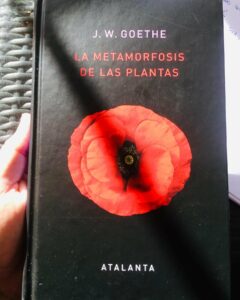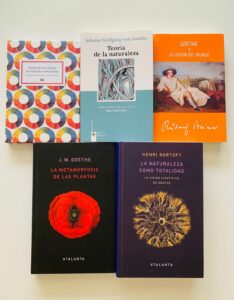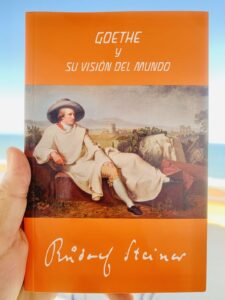Rudolf Steiner, father of biodynamic agriculture, worked for several years at the Johan Goethe Archive in Weimar, studying his scientific writings, which had not been analyzed as a whole. Goethe is the great German writer, the “German Cervantes”, however, he also produced an important scientific work, based on different paradigms. Thanks to them, Steiner gained great inspiration for his work and for the development of his Spiritual Science.
When Steiner gave the lectures on biodynamic agriculture in 1924, he was already at the end of his life process and had greatly developed his writings and his way of seeing the world. In his lectures on biodynamic agriculture, Steiner indicates that his question is: What can Spiritual Science contribute to the agriculture of that time? Where they had already begun to feel and detect changes in food due to the use of chemical fertilizers and herbicides. Steiner was 15 years ahead of the first theories of organic farming.
The question we pose here is what came from Steiner’s Spiritual Science in these courses, and what came from original Goethe’s vision (without this differentiation implying a confrontation between both visions, but simply a questioning about the origin or the source of biodynamic agriculture).
In fact, the name of “bio-dynamics” comes from a Goethean concept: observing the dynamics of life; observing what is alive versus observing what is inert, what is dead, what is separated into parts.
Goethe had a different way of observing natural reality: on the one hand, he incorporated movement, the “dynamics” of life. He wanted to incorporate the impulse of living beings, something that is not reflected in the usual “static physiology” of botany. For him, the transformations of individuals and species not only come from an adaptation and relationship with the context, but are the physical expression of an inner impulse, of a life purpose of each individual, species, place, entity.
On the other hand, in the observation-understanding of the natural world, Goethe did not want to separate the observed object from the observing subject, since for him, this simplification left behind much of the knowledge that can take place. For him, the observer, in this case we, are part of what is observed in a certain sense, and vice versa. In such a way that a deep knowledge of the natural world can only happen methodologically, through the integral connection of the observer and what is observed.
This method of the observer’s participation in what is observed leaves the door open, not only to the transformation of our feeling in observing and belonging to nature as farmers, but also allows other types of knowledge to flourish, if they exist: how the ancestral wisdom of our infinite “being” that contains everything, and among them, the nature that we observe, and of which we are seeds.
Somehow, when we observe, we see the plant in us, for we are one, and in some way, we contain the plant and the knowledge we can create from it.
Goethe’s method was discarded and criticized for the “modern” objective of taking over nature and technically dominating its processes, since it had no practical consequences and complicated the process of understanding. Modern science preferred to limit itself to the external behavior of phenomena and the establishment of quantifiable relationships between them. However, currently we may already be in a position to combine both methodologies, and incorporate music with reason, intuition with thought, poetry with modern science, to achieve superior knowledge.
Goethe did not achieve relevant results in the interests of his historical context, nor did they represent a paradigm shift. It took more than a century for Rudolf Steiner to build an application in the field of agriculture, with the courses he taught on Biodynamic Agriculture in 1924, developing the first intentional method of organic farming, in response to the loss of quality in the food products due to the use of chemical fertilizers.
Steiner observes life, plant dynamics, spirit in matter. Steiner observes the intention, the creative forces to understand the need and identity of each species.
This way of seeing, together with the Goethean idea that in nature there are always “pure” expressions of phenomena, leads Steiner to understand that there is a series of common plants where the basic elements are manifested, associating chamomile, nettle , the ponytail, etc. to the basic elements: sulfur, calcium, silica, etc. This allows you to design simple tools for farmers to use these plants to improve soil fertility and care for their crops.
From this general approach, Steiner manages to translate Goethe’s observation into very specific practices, such as the preparation of special preparations or compost.
Spiritual science and other inputs lead Steiner to conceive in a pioneering way, beyond what Goethe proposed in his writings:
-The different bodies existing in a plant (physical, etheric, astral and spiritual body) and its link with the basic elements: nitrogen, sulfur, potassium, etc.
-The influence on plants not only of the moon and the sun, but of the planets, as well as the consideration of seasonal rhythms and the natural rhythms (vegetable, terrarium and cosmic) involved in agriculture.
-The importance of soil microbiology and preparations, and their promotion through the use of macerations.
-The interaction of the subsoil, the earth and the sky with the plant through forces linked to basic materials such as silica, clay or calcium.
All of these principles were translated by Steiner and related to specific agricultural practices. He brought literature and mysticism down to the daily actions of farmers.
His search could basically be summarized in how to replace synthetic fertilizers with natural fertilizers from the local plant and animal world itself, and how to provide a “plus”, a greater material and spiritual quality to food.
On the other hand, in his practical proposals, Steiner seems to draw on ancestral practices: such as macerations, incinerations or dynamizations, without clearly knowing the sources from which he started beyond spiritual science and his way of achieving higher knowledge ( In his book “How to Achieve Higher Knowledge” Steiner proposes several preliminary exercises in great harmony with Goethe’s proposals). However, it seems that the connection with India of the Theosophists (to which Steiner belonged) or his peasant experiences in his childhood and youth, may also be clues to consider about the origin of his approaches.
Subsequently, biodynamic agriculture has developed and has experimented with Steiner’s approaches, gradually acquiring a very defined methodology. Currently there is a bibliography that greatly helps to know how to make biodynamic preparations, and the use of plants to heal plants, and research is being done to observe material results of these practices. However, the vast majority of biodynamic farmers are unaware of Goethe’s work and do not develop the ability to observe the plant world as Goethe inspired Steiner.
After the readings of Goethe’s scientific writings, and the development that has also been carried out of Goethe’s vision of the plant world, the need arises again to return to the origins, and acquire the human capacity that Goethe tried to promote: learning to observe what is alive, the mystery that life contains. Incorporate poetry, imagination and intuition into scientific thinking and daily agricultural practice, as two indivisible faces that feed on each other.








